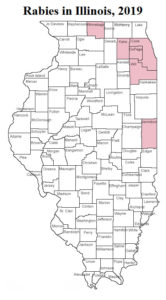We are living in a time when immunizations have become quite controversial and many vaccine preventable diseases are gaining traction in our communities. In June 2019, the Mortality and Morbidly Weekly Reports, the flagship publication of the Centers for Disease Control and Prevention, published a report detailing the impact of high vaccination rates among U.S. pets.

Click for full size
Mass vaccination of dogs against rabies began in 1947. At that time, the canine rabies virus was considered endemic among domesticated animals. Cases of rabies in dogs and the associated human rabies cases fell sharply and by the 1960s, fewer than 500 rabid dog and three human rabies cases were reported annual. Since 2004, canine rabies is considered to have been eliminated in the U. S. At this time, animal rabies exists in populations of skunks, foxes, raccoons and bats; nationally, most human cases are related to raccoons. This is of great concern because the rapid expansion of suburban neighborhoods and housing development on farmland have increased the opportunity for interaction between raccoons, people and domestic pets.
However, most human rabies cases are related to exposure to rabid bats. A variety of explanations have been posited for this. There seems to be a lack of awareness that bats can carry the rabies virus and it can be difficult to identify a bat bite or scratch. Further, while bats are an important reservoir of the rabies virus, over 94% of bats tested for rabies are found to be negative for the virus.
The CDC mentions two threats to the current elimination of rabies in the U. S. First of all, they are concerned that the current antivaccination sentiments in the country could lower the current vaccination rate of 70% in dogs, thereby increasing the likelihood of an outbreak. Secondly, as more and more people move into areas with high populations of wildlife, opportunities for interaction with bats and other potential reservoirs of unvaccinated animals increases.
Citation: Pieracci EG, Pearson CM, Wallace RM, et al. Vital Signs: Trends in Human Rabies Deaths and Exposures — United States, 1938–2018. MMWR Morb Mortal Wkly Rep 2019;68:524–528. DOI: http://dx.doi.org/10.15585/mmwr.mm6823e1.
 Illinois Area Health Education Centers
Illinois Area Health Education Centers